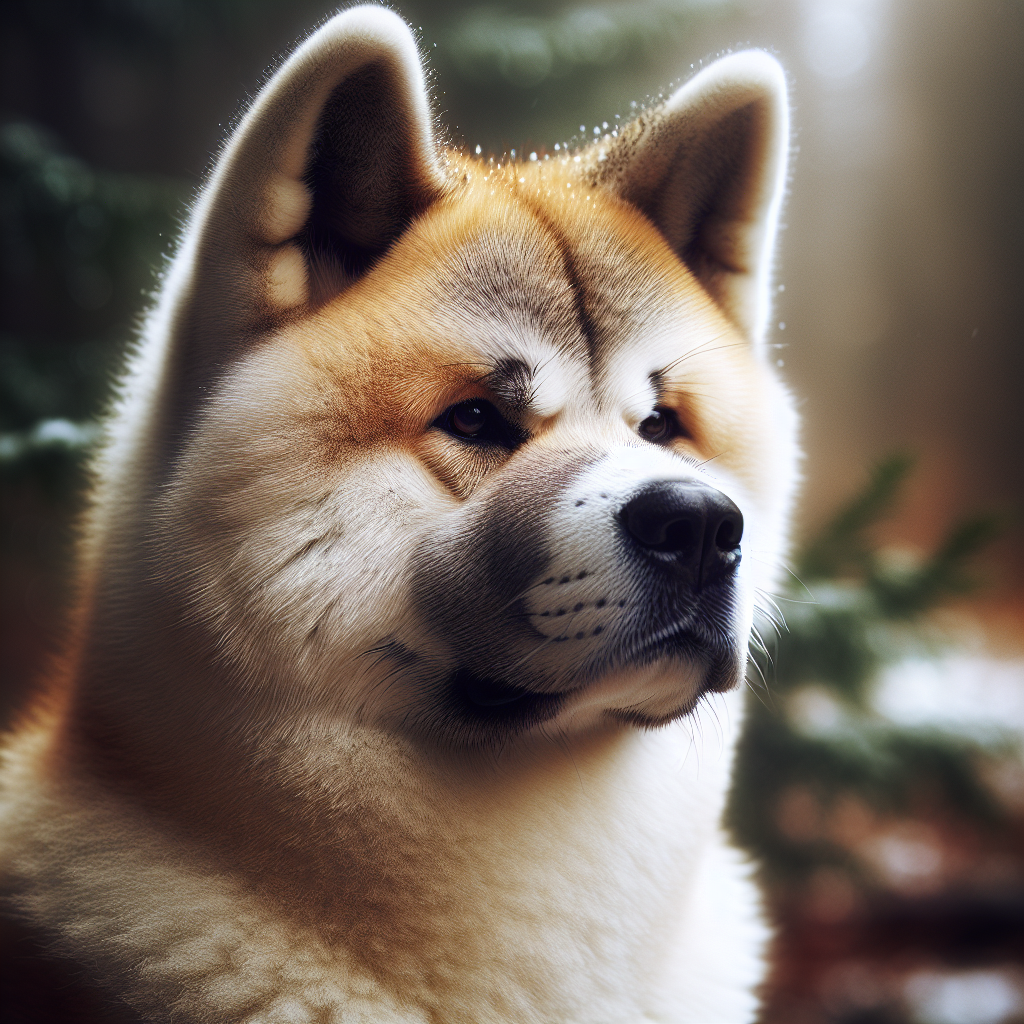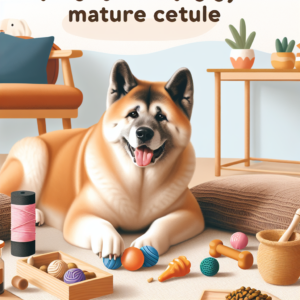Contents
- 1 Introduction to the Breed
- 2 Akita Physical Characteristics
- 3 Akita Temperament and Personality
- 4 Akita Health and Lifespan
- 5 Akita Exercise and Activity Needs
- 6 Akita Training and Intelligence
- 7 Akita Grooming and Maintenance
- 8 Akita Feeding and Nutrition
- 9 Akita Living Arrangements
- 10 Akita Socialization and Interaction
- 11 Conclusion
Introduction to the Breed
The Akita is a majestic and powerful dog with a rich history, originating from Japan’s mountainous regions. This ancient breed was initially developed for hunting large game, including bears, wild boar, and deer. Their imposing size and strength made them highly effective hunters, but they were also revered as loyal protectors and companions, often associated with good health, happiness, and good fortune. Today, Akitas are beloved for their dignified nature and are highly regarded both as working dogs and loyal family companions.
Akitas have been recognized by major dog breed associations, including the American Kennel Club (AKC), where they have been a member of the Working Group since 1972. Their recognition by the AKC helped elevate the breed’s profile in the United States and across the globe. Despite their initial role as a working dog, they are often kept as pets due to their loyalty and protective instincts, making them a popular breed for families and individuals seeking a steadfast companion.
Akita Physical Characteristics
The Akita is a large, muscular dog with a robust build, exuding power and grace. Males typically weigh between 100 to 130 pounds, while females tend to be slightly smaller, ranging from 70 to 100 pounds. Despite their heavy frames, Akitas maintain agility, a trait that was important for their hunting background.
One of the most notable physical features of the Akita is its double-layered coat, which is thick, dense, and designed to protect the dog from harsh weather conditions. The outer coat is harsh and straight, while the undercoat is soft and insulating, making them particularly well-suited to cold climates. Their coat comes in a variety of colors, including white, brindle, and a variety of colors in red, black, and tan combinations. Each Akita has a unique pattern, which adds to their striking appearance.
The Akita’s ears are triangular, thick, and erect, contributing to the breed’s attentive and alert expression. Their tail is another defining feature, curling over the back in a proud, plume-like fashion. This tail, along with the dog’s broad head and intense eyes, adds to the breed’s powerful presence.
Akita Temperament and Personality
The Akita is known for its dignified, loyal, and sometimes aloof temperament. They are a breed that thrives on their independence and will not always seek attention from their owners. However, once an Akita forms a bond with their family, they are incredibly loyal and protective. While they are often reserved with strangers, they are deeply devoted to their owners and their families, making them excellent guardians.
Akitas are also very intelligent dogs, but they are known for their independent nature, which can sometimes make them challenging to train. This breed tends to be strong-willed, so training requires patience, consistency, and positive reinforcement techniques. They do well with structured training, but may not always obey commands immediately, preferring to think things through before acting.
While they are very protective and can be reserved with strangers, Akitas are affectionate with their families, often forming a strong bond with the people they are closest to. They can also be playful, but they generally have a calm and composed demeanor when at home. Their strong guarding instincts, combined with their loyalty, make them excellent watchdogs. However, this same trait means they should be socialized early and consistently to ensure they get along well with other pets and people.
Akita Health and Lifespan
The Akita, being a large breed, is prone to certain health issues, particularly as it ages. Common health concerns include hip dysplasia, hypothyroidism, autoimmune disorders, and progressive retinal atrophy (PRA), a condition that can lead to vision loss. Although these conditions are not guaranteed to affect every Akita, it’s important to be aware of them and to have regular check-ups with a veterinarian to catch any potential issues early.
The average lifespan of an Akita is between 10 to 15 years, with some living even longer with proper care. Maintaining an Akita’s health involves regular veterinary visits, proper nutrition, and appropriate exercise. Given their large size, they are also susceptible to obesity, so it’s important to monitor their weight and adjust their diet accordingly.
Maintaining a healthy lifestyle is crucial for an Akita’s longevity. Joint health is another important aspect, as large dogs can be prone to joint issues. Regular walks, joint supplements, and a controlled diet can help keep an Akita mobile and comfortable throughout their life.
Akita Exercise and Activity Needs
As a working breed, the Akita has a high energy level and requires regular exercise to stay healthy. Daily physical activity is necessary to maintain their weight, build muscle mass, and burn off energy. This breed enjoys walks, runs, and hikes, and it’s essential to provide enough exercise to keep them fit and engaged. However, excessive exercise can strain their joints, so it’s important to strike a balance.
Mental stimulation is equally important for an Akita. While they are highly intelligent, they are also independent thinkers, which means they can become bored if not properly engaged. Puzzle toys, obedience training, and interactive games are excellent ways to challenge their minds. Without mental stimulation, they may develop destructive behaviors or become aloof and disinterested in their surroundings.
Playtime is a critical aspect of maintaining an Akita’s well-being. It helps prevent boredom, strengthens the bond between the dog and their owner, and ensures that the dog remains happy and balanced. Regular play sessions, both indoors and outdoors, are essential for an Akita’s mental and emotional health.
Akita Training and Intelligence
Training an Akita can be a rewarding but challenging experience. They are intelligent dogs that can learn commands quickly, but their independent streak means that they may not always be eager to please in the same way as other breeds. It’s important to approach training with patience, consistency, and positive reinforcement.
Because of their independent nature, Akitas may not respond well to harsh training methods. Instead, using reward-based training, such as treats and praise, is more effective. While Akitas are highly trainable, they can be stubborn at times, so owners need to remain patient and persistent.
Socialization is particularly important for Akitas, as they can be territorial and protective. Early exposure to different people, pets, and environments helps ensure that they become well-adjusted and comfortable in a variety of situations. Akitas can sometimes struggle with other dogs, especially those of the same sex, so controlled introductions and proper training are necessary to ensure positive interactions.
Akita Grooming and Maintenance
Akitas have a thick double coat that sheds heavily, especially during shedding seasons. Regular grooming is essential to keep their coat healthy and reduce shedding. Brushing a few times a week helps remove loose hair, prevent matting, and keep their coat shiny. During peak shedding periods, it’s advisable to brush them daily to manage the increased amount of fur.
Bathing should be done as needed, but it’s important not to over-bathe them, as doing so can strip their coat of its natural oils. Regular ear cleaning and dental care are also important for maintaining overall health. Brushing their teeth regularly and checking their ears for dirt or infection will help prevent common health issues.
In addition to their coat, Akitas need regular nail trimming. Long nails can cause discomfort and may lead to joint or posture issues. Grooming should be done routinely to keep your Akita looking and feeling their best.
Akita Feeding and Nutrition
The Akita’s diet should be carefully managed, as they are prone to obesity and other health issues related to poor nutrition. High-quality dog food that is specifically designed for large breeds is ideal for Akitas. Their diet should consist of protein-rich food to support their muscle mass, along with a balanced mix of vitamins, minerals, and healthy fats.
Akitas also require portion control. Overfeeding can lead to weight gain, which puts stress on their joints and overall health. Feeding them twice a day is typically recommended to regulate their appetite and prevent overeating. It’s important to adjust their portions based on their activity level, age, and metabolism.
Special dietary considerations for Akitas may include foods that support joint health, as they can be prone to hip dysplasia and arthritis. Omega-3 fatty acids and glucosamine supplements can be beneficial for joint health. Always consult with a veterinarian for personalized dietary recommendations.
Akita Living Arrangements
Akitas are best suited to homes with ample space, as they need room to move and exercise. While they can adapt to apartment living, they will need regular walks and playtime to burn off their energy. Having a secure, fenced yard is ideal, as Akitas are strong and may try to escape if they are not adequately contained.
Indoors, Akitas are generally calm, but they do need a space where they can stretch out and relax. They are not a breed that enjoys being crated or confined for long periods, so a home where they can be part of the family and have access to space is ideal.
While Akitas can live in both rural and urban settings, they are more suited to a home where they can have daily outdoor time. They should not be left outside for long periods, especially unsupervised, as they may attempt to escape or wander.
Akita Socialization and Interaction
Early socialization is crucial for Akitas to ensure they interact well with people and other animals. While they are typically loyal and affectionate with their family, they can be reserved or even aggressive towards strangers if not properly socialized. This breed’s natural protective instincts mean that early exposure to different environments, people, and pets is essential to help them become well-adjusted adults.
Akitas are often best suited to homes without other dominant dogs, as they may clash with them. However, they can get along with other dogs if they are properly socialized and trained. Proper introductions and controlled interactions are key to ensuring they learn how to behave around other pets.
Interactions with children are typically positive, but Akitas are large and strong, so supervision is essential, especially around young children. Their natural instinct is to protect their family, but they should be monitored to ensure they are not overly possessive or aggressive.
Conclusion
The Akita is a powerful, independent, and loyal breed with a rich history as a working dog. They make excellent family companions for owners who can provide firm, consistent training, early socialization, and a well-structured environment. While they require a committed owner who understands their needs, Akitas offer unwavering loyalty and protection to those they trust. With proper care, they can be a lifelong, loving companion.


